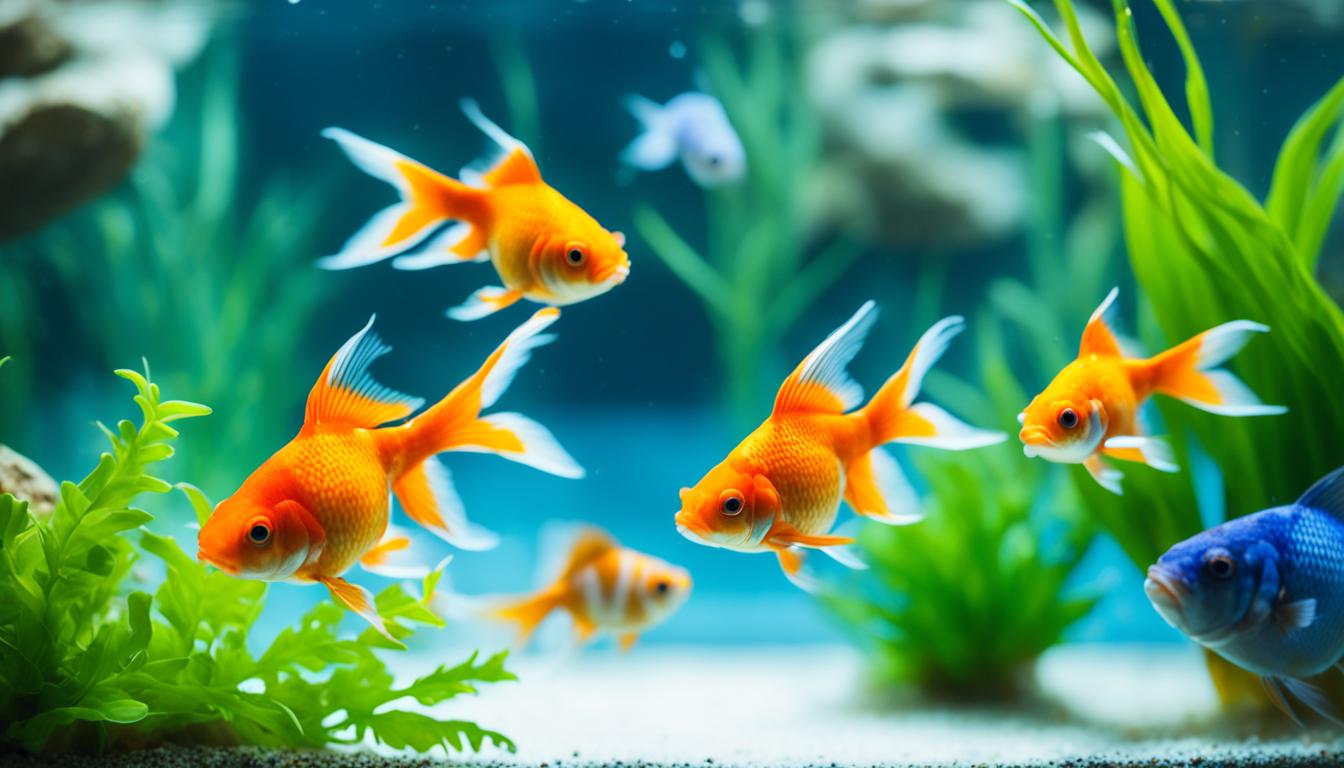Last Updated on 2 weeks by admin
Goldfish are beloved aquatic pets that bring joy and beauty to our lives. As responsible pet owners, it is essential to understand their needs and provide them with the best care possible. One question that often arises is whether goldfish need companionship or if they can thrive happily on their own. Let’s dive deep into the social needs of goldfish and explore whether they truly need friends.
Contrary to popular belief, goldfish are not inherently social creatures in the same way as dogs or humans. They naturally inhabit slow-moving rivers and ponds in East Asia, where they are often found in loose groups. Keeping goldfish alone does not diminish their happiness or well-being, as they are accustomed to a more independent lifestyle.
Providing a solitary environment for your goldfish can actually have its benefits. For one, it reduces competition for food, ensuring that each fish gets its fair share. Additionally, maintaining a tank with just one goldfish simplifies tank maintenance and makes it easier to keep the water clean and balanced.
While goldfish do not require companionship for their happiness, mental stimulation is crucial to prevent loneliness and boredom. Goldfish are intelligent creatures, and they thrive when provided with a stimulating environment. Engaging their natural curiosity through enrichment activities can keep them mentally stimulated and fulfilled.
Key Takeaways:
- Goldfish are not highly social creatures and can thrive in a solitary environment.
- Keeping goldfish alone reduces competition for food and simplifies tank maintenance.
- Companionship is not necessary for a goldfish’s happiness, but mental stimulation is important.
- Enrichment activities can provide the mental stimulation goldfish need to prevent loneliness and boredom.
- Understanding the natural behavior of goldfish helps create a suitable environment for them.
The Nature of Goldfish
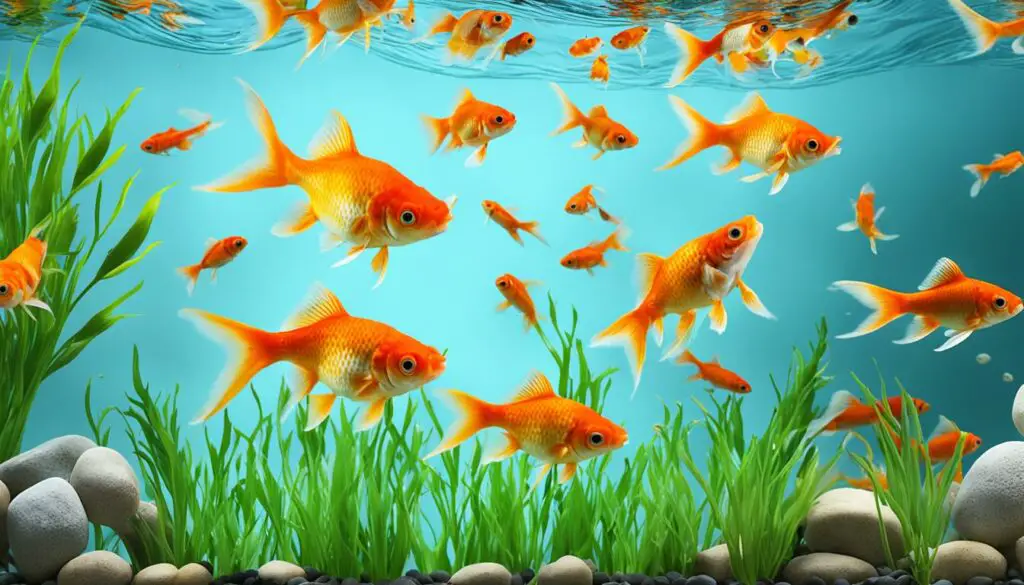
Goldfish are fascinating creatures that have their origins in East Asia. They naturally inhabit slow-moving rivers and ponds, where they thrive in peaceful environments adorned with vegetation. In the wild, goldfish are not highly social and can often be found in loose groups, exploring their surroundings with curiosity.
Understanding the nature of goldfish is essential for creating a suitable habitat for them in captivity. By replicating their natural environment, goldfish can thrive and showcase their vibrant colors and playful behavior.
A Peaceful Habitat
Goldfish prefer a tranquil habitat with calm waters and minimal disturbances. They thrive in environments where they can swim freely, enjoying ample space to explore. Adding plants and decorations to their tank provides goldfish with hiding spots and stimulates their natural instincts.
Behavior in the Wild
In their natural habitat, goldfish exhibit a range of behaviors that reflect their adaptability and resilience. They are skilled explorers and constantly forage for food, keeping their minds and bodies actively engaged. While they are not highly social creatures, goldfish appreciate the presence of other fish in loose groups as it provides a sense of security.
Goldfish are curious beings, always on a quest to discover their surroundings and forage for food. Their natural behavior includes exploring, swimming, and interacting with plants and objects in their environment.
Creating a Captivating Home
When setting up a goldfish tank, creating an environment that mimics their natural habitat is essential. Providing ample swimming space, adding live plants and ornaments, and maintaining appropriate water conditions contribute to the overall well-being of goldfish in captivity.
By understanding the nature of goldfish, we can ensure that they have the best possible environment to showcase their unique characteristics and lead happy, fulfilling lives.
Goldfish Care Basics
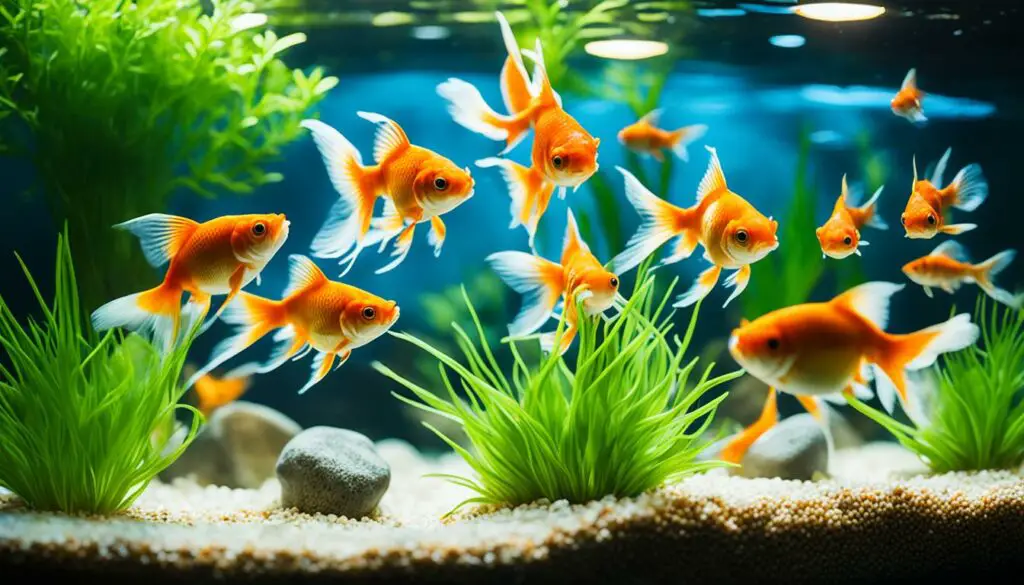
Proper goldfish care is crucial for ensuring the health and well-being of these beautiful aquatic creatures. By providing them with a tank that replicates their natural habitat, maintaining optimal tank conditions, and offering them a nutritious diet, you can help your goldfish thrive.
Aquarium Setup
Creating the right tank conditions is essential to meet the needs of your goldfish. Here’s what you should consider:
- Adequate Space: Goldfish need ample swimming space, so choose a tank size that corresponds to the number and size of your fish. The general rule of thumb is to have a minimum of 20 gallons for one goldfish, with an additional 10 gallons for each additional fish.
- Filtration System: A well-functioning filtration system is critical for maintaining water quality. It helps remove toxins, excess waste, and other impurities, ensuring a healthy environment for your goldfish.
- Temperature Regulation: Goldfish thrive in cooler water temperatures, typically between 65°F and 75°F (18°C – 24°C). Invest in a reliable aquarium heater and thermometer to maintain a consistent temperature.
Regular water changes are necessary to maintain optimal water quality. Aim for a partial water change of about 20-30% every one to two weeks, depending on the size of your tank and the number of goldfish.
Nutrition
Providing your goldfish with a balanced and nutritious diet is vital for their overall health. Here are some key points to keep in mind:
- Quality Fish Food: Choose a high-quality commercial fish food specifically formulated for goldfish. Look for brands that offer a well-balanced diet containing essential nutrients.
- Variety is Key: Goldfish benefit from a varied diet. In addition to dry fish food, incorporate occasional feedings of fresh or frozen foods like brine shrimp, bloodworms, and daphnia. This helps provide them with additional nutrients and mental stimulation.
- Avoid Overfeeding: Overfeeding is a common mistake that can lead to poor water quality and health issues for your goldfish. Feed them small portions a few times a day, and only offer what they can consume within a few minutes.
Remember, maintaining proper nutrition plays a vital role in keeping your goldfish healthy and resilient.
| Key Points | Benefits |
|---|---|
| Maintain optimal tank conditions | Ensures a healthy environment for goldfish |
| Regular water changes | Preserves water quality and prevents toxin buildup |
| Provide a balanced diet | Promotes good health and vibrant coloration in goldfish |
| Avoid overfeeding | Prevents digestive issues and maintains water quality |
By following these goldfish care basics, you can create a thriving environment for your aquatic companions.
Can a Goldfish Live Alone?
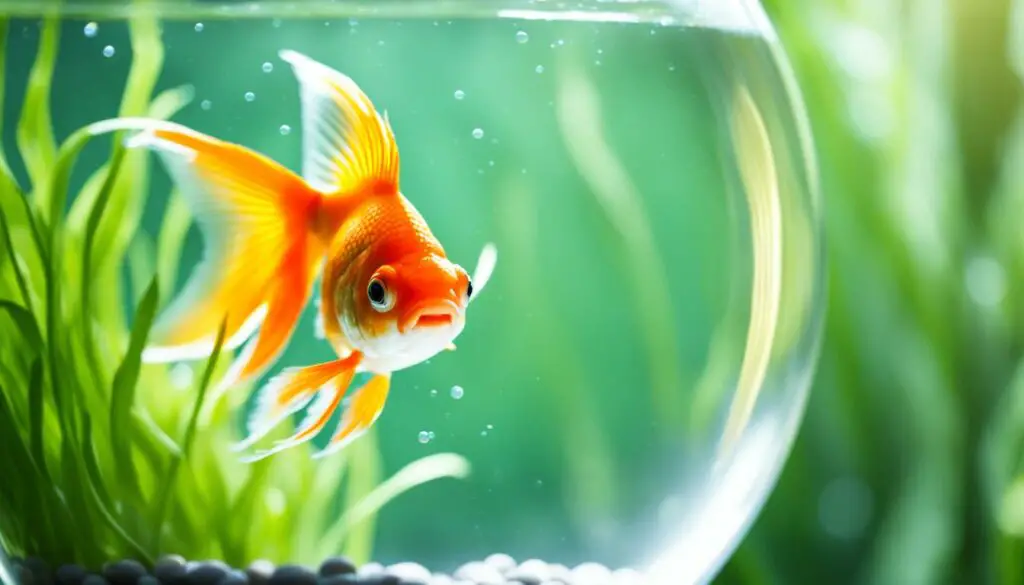
Goldfish can indeed live alone and still flourish in their environment. Contrary to popular belief, solo goldfish experience several benefits that contribute to their overall well-being.
One major advantage of keeping a goldfish alone is the reduction in competition for food. In a tank shared with other fish, there may be instances where certain individuals dominate the feeding frenzy, leaving others with less opportunity to consume an adequate amount of food. When a goldfish is the sole occupant of the tank, they have unfettered access to their meals, ensuring they receive the necessary nutrition for optimal health.
Additionally, having a solo goldfish simplifies tank maintenance. Sharing a living space with other fish can lead to increased waste production and a higher risk of water contamination. By housing a goldfish alone, owners can more easily monitor and maintain the tank conditions, preventing potential issues related to water quality.
While goldfish are not highly social creatures, companionship is not necessary for their happiness. They do not require constant interaction or stimulation from other fish to lead fulfilling lives. Goldfish are content and thrive in environments that provide appropriate physical and mental stimulation.
“Goldfish are naturally found in loose groups rather than tight-knit schools. They are not dependent on social interactions for their well-being.”
However, it is worth noting that some argue that companionship can offer mental stimulation and alleviate potential boredom in goldfish. Observing the presence of another fish may provide visual interest and create a more dynamic environment. It is ultimately up to the owner to assess the individual needs and preferences of their goldfish when considering companionship.
Overall, goldfish can live alone successfully, benefiting from reduced competition for food and simplified tank maintenance. While companionship is not essential for their happiness, providing mental stimulation and a suitable environment remains crucial to ensure their well-being.
Signs of Loneliness in Goldfish
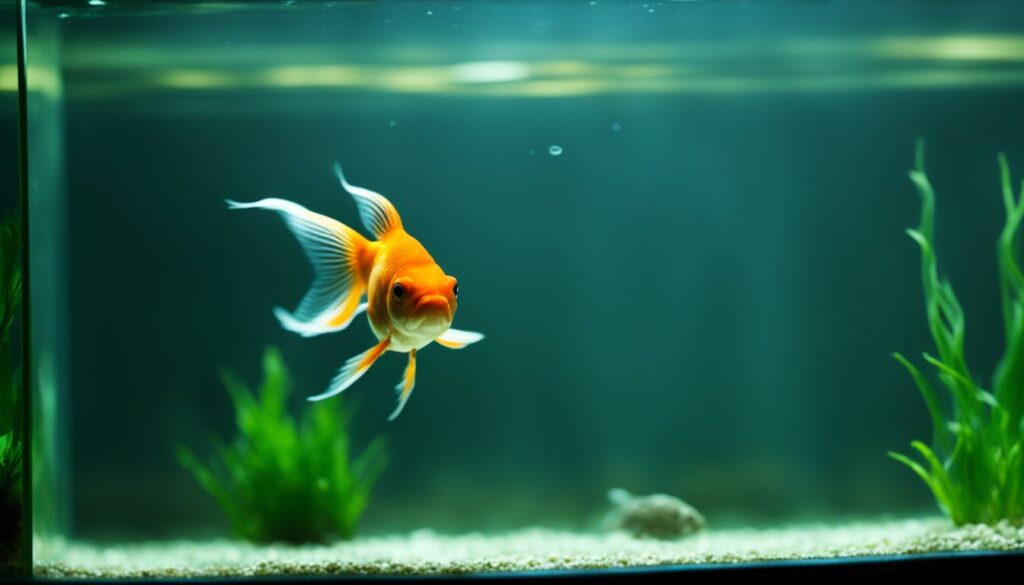
Even though goldfish are not highly social creatures, they can still experience loneliness if their environment lacks mental stimulation and companionship. It’s important for goldfish owners to be aware of the signs that indicate their fish may be feeling lonely.
Excessive Hiding
One of the signs of loneliness in goldfish is excessive hiding. If your goldfish constantly retreats to corners or hides behind decorations, it could be a sign that it is feeling lonely and seeks a sense of security. Creating a hiding spot with plants or adding a cave-like structure to the tank can help alleviate this behavior.
Listlessness
Lonely goldfish may also display listless behavior. They may appear lethargic, lack energy, and swim aimlessly in the tank. This can be a result of the lack of mental and social stimulation. Engaging your goldfish with enrichment activities, as mentioned in the previous sections, can help combat listlessness.
Loss of Interest in Food
If your goldfish has suddenly lost interest in food, it could be a sign of loneliness. Goldfish are known for their voracious appetite, and a loss of appetite can indicate stress or depression. It’s important to monitor your goldfish’s eating habits and address any potential signs of loneliness.
By observing these signs and understanding the behavior of your goldfish, you can take appropriate measures to ensure their overall well-being. Providing mental stimulation and considering companionship options, which will be discussed in later sections, are key to enhancing the quality of life for your goldfish.
Enrichment Activities for Solo Goldfish
Keeping solo goldfish entertained is crucial for their mental stimulation and overall well-being. Although they can live alone, engaging them in enrichment activities can help prevent boredom and ensure a healthy life. Here are some creative ideas to keep your solo goldfish entertained:
“Enrichment activities are essential for solo goldfish to prevent boredom and promote mental stimulation.”
1. DIY Toys
Create simple and inexpensive toys using everyday items to engage your goldfish’s curious mind. Try floating ping pong balls in the tank, which can become interactive play objects for your goldfish. The movement of the ball in the water will arouse their interest and keep them entertained.
2. PVC Pipe Tunnels
Goldfish enjoy exploring narrow spaces. Consider adding PVC pipe tunnels to their tank. These tunnels provide a stimulating environment for your goldfish to swim through, promoting physical activity and mental engagement.
3. Rearrange Decorations
A change in the tank environment can pique your goldfish’s curiosity. Rearrange the decorations periodically to create new swimming routes and hiding spots. This simple activity introduces novelty and keeps your goldfish interested.
4. Introduce Live Plants
Adding live aquarium plants not only enhances the aesthetics of the tank but also improves the goldfish’s environment. Plants provide hiding places, improve water quality, and create a more natural habitat. Your goldfish will enjoy exploring and interacting with the plants.
“Goldfish can thrive and stay entertained with simple changes and additions to their tank.”
5. Change and Variety
Goldfish thrive on change and variety. Incorporate different enrichment activities regularly to keep your goldfish mentally stimulated. Alternate between toys, decorations, and plant arrangements to prevent monotony and promote a healthy, vibrant life.
Remember, goldfish may not require companionship, but they still need mental stimulation and an engaging environment. By implementing these enrichment activities, you can ensure that your solo goldfish stays entertained, active, and happy.
Goldfish Recognition and Bonding
Goldfish are often underestimated in their ability to recognize their owners and form bonds. While they may not display the same level of affection as dogs or cats, they can exhibit behaviors that indicate recognition and respond to their owners’ presence.
One common behavior goldfish exhibit when recognizing their owners is swimming towards them. They may eagerly approach the front of the tank or pond, eagerly anticipating feeding time. This recognition can be a result of the owner consistently providing food, creating a positive association.
An interesting aspect of goldfish recognition is their ability to distinguish between different humans. They can recognize familiar faces and show preference towards certain individuals. This recognition is believed to be based on visual cues, such as facial features or body movements.
Goldfish bonding, however, is different from the strong emotional bonds experienced with other pets. While they can display social behaviors, such as swimming in groups or following each other’s movements, their level of attachment is less intense. Goldfish are naturally not highly social creatures, preferring loose groups in their natural habitat.
It is important for goldfish owners to understand that while recognition and bonding are possible, goldfish still require mental stimulation and a suitable environment to thrive. Providing varied enrichment activities can keep them engaged and prevent loneliness and boredom.
Goldfish can recognize their owners and display social behaviors, but their level of bonding is not as strong as with other pets. Understanding their capacity for recognition and creating a stimulating environment is crucial for their well-being.
| Behaviors indicating goldfish recognition: | Goldfish bonding behaviors: |
|---|---|
|
|
Goldfish and Emotional Expression
While goldfish may not have the same emotional range as mammals, they are capable of experiencing a range of emotions to some extent. They can exhibit behaviors that indicate their emotional state, providing insight into their well-being and responsiveness to their environment.
Goldfish, like any living creature, can experience fear and stress. They may exhibit behaviors such as hiding, darting, or attempting to escape when they feel threatened or unsafe. These behaviors are indicative of their emotional response to perceived danger.
On the other hand, goldfish can also experience pleasure and contentment. When they are in a comfortable and enriched environment, they may display behaviors such as swimming freely, exploring their surroundings, and eagerly seeking food. These behaviors signify their positive emotional state and satisfaction.
| Emotion | Indicative Behaviors |
|---|---|
| Fear/Stress | Hiding, darting, attempting to escape |
| Pleasure/Contentment | Swimming freely, exploring, eagerly seeking food |
It’s important to observe and understand goldfish behavior to gauge their emotional well-being. By providing a suitable environment with proper tank conditions, varied enrichment activities, and a balanced diet, you can help foster positive emotions in your goldfish and ensure their overall happiness.
Creating an Enriching Environment for Goldfish
Goldfish thrive in an environment that stimulates their curious nature and provides opportunities for mental engagement. Here are some tips to create an enriching environment:
- Add hiding spots and decorations to mimic natural habitats.
- Introduce live plants to provide mental stimulation and offer a natural foraging experience.
- Rotate and rearrange tank decor to provide variety and prevent boredom.
- Use floating toys or objects such as ping pong balls for them to interact with.
- Ensure proper filtration and water quality to maintain a healthy living environment.
“Goldfish are fascinating creatures capable of experiencing a range of emotions despite their differences from mammals. By creating an enriching environment and observing their behaviors, we can better understand their emotional well-being and ensure they lead happy and fulfilling lives.”
Goldfish and Hobbyist Interaction
Interacting with goldfish can be a rewarding experience for both the fish and the hobbyist. Goldfish are intelligent creatures that can show recognition and respond to their owners’ presence. They exhibit behaviors such as swimming to the front of the tank and being attentive when their owners approach.
Training goldfish can also be a fun and engaging activity. These remarkable creatures can learn to perform certain tasks, navigate through mazes, and even swim in synchronized routines. With patience, consistent training, and positive reinforcement, goldfish can showcase their intelligence and ability to learn.
Here are some ways to interact and train your goldfish:
- Use target training: Introduce a small target, such as a colored stick or a floating object, and reward the goldfish with food when it follows the target. Over time, you can gradually increase the difficulty by adding obstacles or making the target movements more complex.
- Create an obstacle course: Set up a mini obstacle course in the tank using objects like hoops or tunnels. Encourage the goldfish to swim through the course and reward its successful completion with treats.
- Teach tricks: Goldfish can be trained to perform tricks like swimming through a hoop or pushing a tiny ball. Break down the trick into small steps, reward each successful attempt, and gradually build up to the final performance.
Remember, goldfish have a limited memory span, so keep training sessions short and frequent for better results. Be patient and use positive reinforcement techniques to motivate your goldfish and make the training experience enjoyable for both of you.
“Training goldfish can be a wonderful way to build a deeper connection with these fascinating aquatic pets. It allows you to tap into their intelligence and stimulate their minds. Plus, seeing your goldfish perform tricks or respond to your cues can be incredibly rewarding!”
Conclusion
After exploring the social needs of goldfish, it can be concluded that they can live alone and still lead happy and healthy lives. While goldfish are not highly social creatures, they still require mental stimulation and a suitable environment to thrive. Understanding their natural behavior and providing enrichment activities are crucial for ensuring their well-being.
Goldfish are naturally found in loose groups rather than tight-knit schools, which means they do not require companionship for their happiness. Keeping goldfish alone reduces competition for food and simplifies tank maintenance. However, it is important to prevent loneliness and boredom by offering mental stimulation through various enrichment activities.
By mimicking their natural habitat and incorporating DIY toys, rearranging decorations, or introducing live plants, solo goldfish can stay engaged and mentally stimulated. Additionally, observing their behavior closely is essential to spot any signs of loneliness or distress. Goldfish recognition and bonding with their owners are also evident, showing that they can still exhibit social behaviors.
FAQ
Do goldfish need companions or friends to thrive?
No, goldfish can thrive in a solitary environment as they are not highly social creatures. However, mental stimulation is important to prevent loneliness and boredom.
What is the natural behavior and habitat of goldfish?
Goldfish are originally from East Asia and naturally inhabit slow-moving rivers and ponds. They are not highly social and often found in loose groups.
What are the basic care requirements for goldfish?
Proper goldfish care involves providing a tank that mirrors their natural habitat, including adequate space, filtration, and temperature. Regular water changes and a balanced diet are also important.
Can goldfish live alone?
Yes, goldfish can live alone and still thrive. Solo goldfish experience less competition for food and have simpler tank maintenance. Companionship is not necessary for their happiness, but mental stimulation is important.
What are the signs of loneliness in goldfish?
Excessive hiding, listlessness, and loss of interest in food can be signs of loneliness in goldfish. Mental stimulation is important to prevent boredom and stress.
How can I keep my solo goldfish entertained?
Keeping solo goldfish entertained can be done by providing DIY toys, rearranging decorations, and introducing live plants. Change and variety in the environment keep goldfish interested and prevent boredom.
Can goldfish recognize their owners and form bonds?
While goldfish may not form strong affectionate bonds like dogs or cats, they can recognize their owners and exhibit social behaviors, such as swimming towards them and responding to their voices.
Do goldfish experience emotions?
Goldfish are capable of experiencing emotions to some extent, including fear, stress, and pleasure. They can exhibit behaviors that indicate their emotional state, although their emotional range is not as complex as mammals.
How can I interact with my goldfish?
Goldfish can be interacted with by observing their behavior, training them to perform certain tasks, and providing enrichment activities. Interaction with goldfish can be enjoyable for both the fish and the hobbyist.
Can goldfish thrive without companions?
Yes, goldfish can live alone and still lead happy and healthy lives. While they are not highly social creatures, they need mental stimulation and a suitable environment to thrive.
Source Links
- https://psychology.fandom.com/wiki/Goldfish
- https://www.reptileknowledge.com/reptile-pedia/how-can-i-communicate-with-my-goldfish
- https://www.fishtrivia.com/can-a-goldfish-live-alone/

